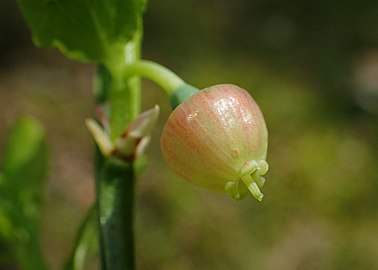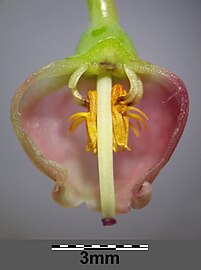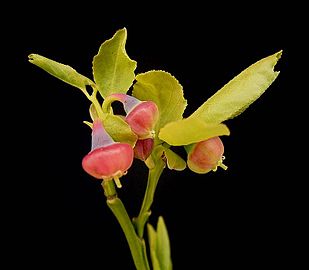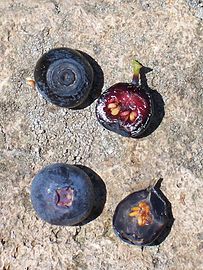Vaccinium myrtillus
| Vaccinium myrtillus | |
|---|---|

| |
| By Amédée Masclef, published in Atlas des plantes de France, 1891 | |
| Scientific classification | |
| Kingdom: | Plantae |
| Clade: | Tracheophytes |
| Clade: | Angiosperms |
| Clade: | Eudicots |
| Clade: | Asterids |
| Order: | Ericales |
| Family: | Ericaceae |
| Genus: | Vaccinium |
| Subgenus: | Vaccinium subg. Vaccinium |
| Section: | Vaccinium sect. Myrtillus |
| Species: | V. myrtillus |
| Binomial name | |
| Vaccinium myrtillus L. 1753 | |
| Synonyms[2] | |
| |
Vaccinium myrtillus or European blueberry is a holarctic species of shrub with edible fruit of blue color, known by the common names bilberry, blaeberry, wimberry, and whortleberry.[3] It is more precisely called common bilberry or blue whortleberry to distinguish it from other Vaccinium relatives.
Description
Vaccinium myrtillus is a small deciduous shrub that grows 10–51 cm (4–20 in) tall, heavily branched with upright, angular to narrow winged, green-colored branches that are glabrous. It grows rhizomes, creating extensive patches The shrub can live up to 30 years, with roots reaching depths of up to 1 metre (3+1⁄2 ft). It has light green leaves that turn red in autumn and are simple and alternate in arrangement.[4] The leaves are 1–3 cm (3⁄8–1+1⁄8 in) long and ovate to lanceolate or broadly elliptic in shape, with glandular to finely toothed margins;[4] they are prominently veined on the lower surface. In winter, the foliage turns deep red and becomes deciduous.
Small, hermaphrodite flowers with thick stems (about 2–3 millimetres or 1⁄16–1⁄8 inch long) grow individually from the leaf axils and nod downward. These flowers, blooming from April to May, have crowns 4 to 6 mm long that are greenish to reddish. The small calyx is fused with minimal lobes on the cup-shaped flower. The rounded, urn-shaped pink petals have short, curved lobes. The 8–10 stamens are short, and the anthers are awned and horned. The four- or five-chambered ovary is inferior with a long style.
From July to September, the plants produce black-blue, flattened, round fruits with a maximum diameter of 1 cm. These multi-seeded berries have calyx remnants on the tip and a blue-gray frosted appearance. Rarely, forms with white, yellow, red, or reddish-spotted berries occur. The small, brownish seeds are crescent-shaped. This species differs from V. corymbosum in that its anthocyanins, which produce color, are found in both the peel and the flesh.
Chromosome count is 2n=24.[5][6]
- Rhizomes
- Flowers on inflorescens
- Flower
- Flower cross-section
- Mature flowers
- Fruits
- Fruit cross section showing red flesh (top) compared to V. uliginosum
Chemistry
Bilberry and the related V. uliginosum both produce lignins, in part because they are used as defensive chemicals.[7] Although many plants change their lignin production – usually to increase it – to handle the stresses of climate change, lignin levels of both Vaccinium species appear to be unaffected.[7] The leaves contain catechins, tannins, quinic acid, arbutin, chlorogenic acid, various glycosides, the fruits contain anthocyanins, pectin, ursolic acid, chlorogenic acid, and ascorbic acid.[8]
V. myrtillus contains a high concentration of triterpenes which remain under laboratory research for their possible biological effects.[9]
Common names
Regional names include blaeberry (Scotland), urts or hurts (Cornwall and Devon),[10] hurtleberry,[11] myrtleberry,[12] wimberry, whinberry, winberry,[13] and fraughan.[14]
Distribution and habitat
Vaccinium myrtillus is a Holarctic species native to almost every country in Europe, north and central Asia, Japan, Greenland, Western Canada, and the Western United States. Within Europe it is only absent from Sardinia, Sicily, the European portion of Turkey, Crete, the Aegean Islands, Cyprus, Crimea, and southern European Russia.[15] It occurs in the acidic soils of heaths, boggy barrens, moorlands, degraded meadows, open forests at the base of pine and mountain spruce forest, and parklands, slopes, and moraines at elevations up to 2,350 m (7,710 ft).[16][17]
- Habitat in the Spandau forest, Germany
- Habitat in of pine forest understory in Czermnica, Poland
- Habitat around Apennine Mountains, Italy
Toxicity
Consuming the leaves may be unsafe.[3]
Uses
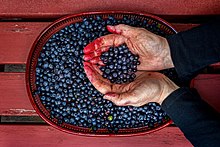
The fruits will stain hands, teeth and tongue deep blue or purple while eating and so it was traditionally used as a dye for food and clothes in Britain.[18]

Fruit
Vaccinium myrtillus has been used for centuries in traditional medicine, particularly in traditional Austrian medicine as a tea or liqueur in attempts to treat various disorders.[19] Bilberry dietary supplements are marketed in the United States, although there is little evidence these products have any effect on health or diseases.[3]
In cooking, the bilberry fruit is commonly used for pies, tarts and flans, cakes, jams, muffins, cookies, sauces, syrups, juices, and candies.[3]
Although bilberries are in high demand by consumers in Northern Europe, the berries are harvested in the wild without any cultivation. Some authors state that opportunities exist to improve the crop if cultivated using common agricultural practices.[20]
Leaves
In traditional medicine, the (potentially toxic) leaves were mainly used for treating skin disorders.[3]
See also
- Blaeberry River
- Mahonia aquifolium (Oregon grape)
- Myrtus
References
- ^ NatureServe (2024). "Vaccinium myrtillus". Arlington, Virginia. Retrieved 10 April 2024.
- ^ Vaccinium myrtillus L. The Plant List
- ^ a b c d e "Bilberry". National Center for Complementary and Integrative Health, US National Institutes of Health. 1 August 2020. Retrieved 4 October 2022.
- ^ a b "Vaccinium myrtillus". www.fs.usda.gov. Retrieved 2022-09-13.
- ^ Oberdorfer, Erich (2001). Pflanzensoziologische Exkursionsflora für Deutschland und angrenzende Gebiete (in German). Stuttgart: Ulmer. p. 732. ISBN 3-8001-3131-5.
- ^ "Bilberry". GDV. Retrieved 2024-07-08.
- ^ a b Bidart-Bouzat, M. Gabriela; Imeh-Nathaniel, Adebobola (2008). "Global Change Effects on Plant Chemical Defenses against Insect Herbivores". Journal of Integrative Plant Biology. 50 (11): 1339–1354. doi:10.1111/j.1744-7909.2008.00751.x. ISSN 1672-9072. PMID 19017122.
- ^ "Vaccinium myrtillus". Dr. Duke's Phytochemical and Ethnobotanical Databases. Retrieved 2024-06-18.
- ^ Szakiel, Anna; Pączkowski, Cezary; Pensec, Flora; Bertsch, Christophe (2012). "Fruit cuticular waxes as a source of biologically active triterpenoids". Phytochemistry Reviews. 11 (2–3): 263–284. Bibcode:2012PChRv..11..263S. doi:10.1007/s11101-012-9241-9. ISSN 1568-7767. PMC 3601259. PMID 23519009.
- ^ Phillipps, K. C. (1993). A Glossary of the Cornish Dialect. Padstow: Tabb House. p. 57. ISBN 0-907018-91-2.
- ^ "Vaccinium myrtillus". Germplasm Resources Information Network. Agricultural Research Service, United States Department of Agriculture. Retrieved 12 December 2017. citing Wiersema, J. H. & B. León (1999), World economic plants: a standard reference, and Huxley, A., ed. (1992), The new Royal Horticultural Society dictionary of gardening
- ^ "Bilberry, Blaeberry, Whortleberry, Whinberry, Windberry, Myrtle Berry, Vaccinium myrtillus". Wild Food UK. Retrieved 2020-07-31.
- ^ Henley, Jon. Bilberries: the true taste of northern England, The Guardian, Monday 9 June 2008
- ^ "Fraughan is an anglicisation of the Irish word Fraochán (or heather fruit, as the plant is often found growing with heather)". téarma.ie.
- ^ "Vaccinium myrtillus L." Plants of the World Online. Royal Botanic Gardens, Kew. Retrieved 27 June 2024.
- ^ "Vaccinium myrtillus Linnaeus". Flora of North America. Retrieved 2021-09-21.
- ^ "Vaccinium myrtillus L." USDA Plants Database. Retrieved 2021-09-21.
- ^ "Make Traditional Dyes – Bilberry Dye". Barley Hall. York Archaeological Trust, Arts Council England and VisitEngland. Archived from the original on 2012-04-21.
- ^ Vogl S, Picker P, Mihaly-Bison J, Fakhrudin N, Atanasov AG, Heiss EH, Wawrosch C, Reznicek G, Dirsch VM, Saukel J, Kopp B (2013-03-25). "Ethnopharmacological in vitro studies on Austria's folk medicine--an unexplored lore in vitro anti-inflammatory activities of 71 Austrian traditional herbal drugs". J Ethnopharmacol. 149 (3): 750–71. doi:10.1016/j.jep.2013.06.007. PMC 3791396. PMID 23770053.
- ^ Nestby, Rolf; Percival, D.; Martinussen, Inger S.; Opstad, Nina; Rohloff, Jens (January 2011). "The European Blueberry (Vaccinium myrtillus L .) and the Potential for Cultivation. A Review" (PDF). The European Journal of Plant Science and Biotechnology. S2CID 52997599.




